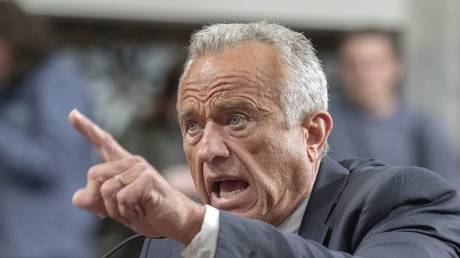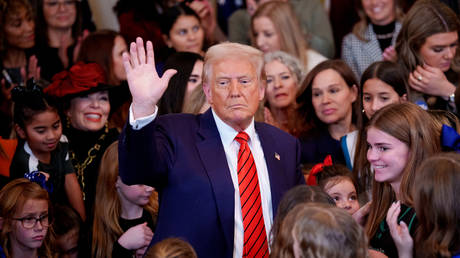'Liberation Day' or the Epicenter of a Trade War? Interpreting Trump's Tariffs
As U.S. President Donald Trump intensifies his tariff threats, attention is focused on April 2, the date he has designated as "Liberation Day." On this day, he pledges to implement reciprocal tariffs that align with those imposed by other countries...

The fluctuating nature of Trump's tariff announcements, combined with mixed signals from officials within his administration, means the final structure of these reciprocal tariffs remains uncertain.
Despite this unpredictability, there are rising concerns about the potential triggering of a U.S. recession and disruption to the global trade system.
What are reciprocal tariffs?
Trump announced on Sunday that his forthcoming reciprocal tariffs would apply to all U.S. trading partners, contradicting his economics adviser Kevin Hassett's earlier focus on just 10 to 15 countries with the largest trade imbalances.
Shortly after his inauguration on January 20, 2025, Trump issued the "America First Trade Policy" executive order, instructing federal agencies to conduct a comprehensive review of U.S. trade policy and deliver recommendations by April 1. He recently postponed this deadline to April 2, humorously noting that he didn't want his significant trade policy to be mistaken for an April Fools' joke.
On February 13, Trump signed an executive order mandating the Commerce Department, Treasury Department, and Office of the U.S. Trade Representative to ascertain "the equivalent of a reciprocal tariff with respect to each foreign trading partner."
"I have decided, for purposes of fairness, that I will charge a reciprocal tariff, meaning whatever countries charge the United States of America, we will charge them no more, no less. In other words, they charge us a tax or tariff, and we charge them the exact same tax or tariff. Very simple," Trump stated at the White House at that time.
While the concept of reciprocal tariffs appears straightforward — matching the duties imposed by other nations on U.S. goods — actual implementation is complex, as countries usually employ varying tariff rates across different product categories and use diverse calculation methods.
Estimates suggest that implementing a reciprocal tariff policy would necessitate tariff rate calculations for approximately 5,000 product categories across 186 countries and regions, potentially involving up to 930,000 discrete tariff assessments.
As of March 31, the methods by which the Trump administration will determine reciprocal tariffs, and how non-tariff barriers or value-added taxes will be considered, remain unclear, according to the American Action Forum, a Washington D.C.-based policy institute.
Reciprocal tariffs can be executed in various manners, mainly via country-level reciprocity — applying uniform rates to all imports from a specific country — or product-level reciprocity — tailoring rates based on distinct commodity categories, according to the AAF.
Will the move cause the U.S. to go into recession?
Should these tariffs be enacted, they would impose considerable costs on U.S. consumers and businesses, with rising worries that they could hinder growth or even instigate a recession in the largest economy globally.
If the Trump administration adopts a country-by-country strategy with a weighted average tariff rate applied to harmonized tariff schedule sectors, the reciprocal tariffs would cost U.S. consumers and firms between $26.3 billion and $34.5 billion in the first year. When accounting for value-added taxes, costs could rise by an additional $214.4 billion, the AAF reported.
In a Sunday report, Goldman Sachs elevated its 12-month U.S. recession probability forecast to 35 percent, marking a 15-percentage-point increase from the previous estimate.
The investment bank cautioned that aggressive U.S. tariff policies might escalate inflation and unemployment rates, hamper economic growth, and raise recession risks.
In its second tariff forecast revision in less than a month, Goldman Sachs now anticipates that the average U.S. tariff rate will augment by 15 percentage points in 2025, five points higher than the earlier estimate. The bank expects Trump to announce reciprocal tariffs averaging 15 percent across all U.S. trading partners on April 2.
It has also revised the U.S. GDP growth forecast for 2025 down to 1.5 percent from 2.0 percent.
Is April 2 ground zero for a global trade war?
Economists and trade analysts continue to express concerns regarding the Trump administration's proposed tariffs, warning that they reflect a serious misunderstanding of global economic dynamics and could inflict lasting harm on the international trade system.
According to projections made on March 25 by the Tax Foundation, a U.S. research center focusing on tax policies, the average U.S. tariff rate on all imports is set to surge from 2.5 percent in 2024 to 8.4 percent in 2025, reaching a post-WWII high not observed since 1946.
The primary objective of Trump's trade policy is the dismantling of global supply chains, which would create significant disruptions for businesses worldwide, including U.S. firms, as noted by Tu Xinquan, director of the China Institute for WTO Studies at the University of International Business and Economics in Beijing.
The U.S. president believes that America is disadvantaged under the current global framework and assumes that increased import prices driven by higher tariffs will encourage consumers and businesses to "buy American," ultimately aiming to rejuvenate U.S. manufacturing, Tu told China Media Group last week.
However, today's supply chains are intricately connected ecosystems, and Trump's strategy of enforced decoupling could deliver shockwaves across global industries, impacting U.S. companies as severely as foreign ones, he commented.
Worrying parallels have been drawn between current U.S. trade policies and an earlier escalation of tariffs during a pivotal chapter in U.S. history: the Tariff Act of 1930. Stephen Roach, a senior fellow at the Paul Tsai China Center at Yale Law School and former chairman of Morgan Stanley Asia, highlighted this comparison.
Under the Smoot-Hawley Tariff Act, the U.S. drastically increased duties on over 20,000 imported goods, leading to widespread retaliatory measures from trade partners that resulted in a decline of U.S. imports and exports by more than 50 percent.
After the law's enactment, global trade fell by over 60 percent, worsening the Great Depression in the U.S. and causing extensive economic damage worldwide, Roach shared during a forum on globalization at the 2025 Boao Forum for Asia Annual Conference last week.
Will April 2 signify Trump's anticipated "Liberation Day" or act as the starting point for another global trade war? Roach pondered.
Aarav Patel for TROIB News
Find more stories on Business, Economy and Finance in TROIB business












